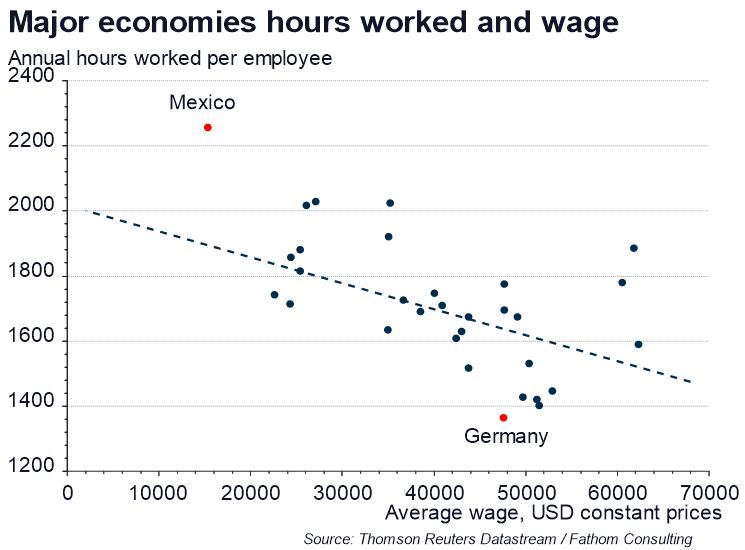A sideways look at economics
When I think about Mexico I think of its rich culture, great people, delicious food, mezcal, and Germany’s disillusioning defeat during last year’s football World Cup. Mexico has a lot going for it economically, too — it’s one of the richest economies in Latin America. In terms of economic growth, Mexico has outpaced the rest of Latin America for the past five years. Inflation has been stable since the early 2000s (at least until recently, but that’s more to do with policies across Mexico’s northern border). However, Mexico is also the country of long working hours and low wages.
When visiting the country recently, a Mexican friend told me that she’s only entitled to 14 days of annual leave. To my surprise, she claimed to have a relatively high number of leave days, as she has been working for several years for her current employer. In Mexico, statutory leave — the minimum amount of paid holiday to which a full-time employee is legally entitled — depends on the number of years worked for the same employer.
Statutory leave varies enormously from country to country. With six days, Mexico has the second smallest amount of statutory leave among major economies. Only the US has less: none. (By the way, the UK sits at the top of the tree with 28 days of statutory leave, including any public holidays observed by the firm.) An earlier TFiF even addressed the thorny question of whether it’s possible to have too much leave.
Limited vacation time implies relatively more working time. Indeed, in 2017 the average employee in Mexico worked the most hours on average across major economies: 2257 hours. The equivalent figure for the UK was a more than a quarter lower.
In another previous TFiF, we discussed how increases in productivity, which should lead to higher wages, might have led to fewer working hours in the UK. Our chart shows this relationship at a single point in time, 2017, across the major economies. Mexico is an outlier, as is Germany. Indeed, Mexico’s workers put in the most hours while earning the least, on average. The trend line shows how much workers across major economies tend to work on average for a given level of income. Mexico’s data point is north of the trend line; even relative to other major economies with similar wages, employees in Mexico worked disproportionately more hours in 2017.
Germany’s data point is the one that is the furthest below the trend line. Germany’s employees work (a lot) less than those in other major economies with a similar level of wealth. This was on display watching the football team play. Not that I’m still sour about Germany’s World Cup performance…

What might explain the different outcomes for workers in Mexico and Germany? When negotiating the allocation of economic surpluses, it’s workers’ bargaining power that matters. This bargaining power is determined by factors such as union representation and the alternatives to the status quo. Mexico’s labour market is characterised by high informality, lack of union representation and a low minimum wage.
In 2018, only 30% of Mexico’s economically active population had permanent contracts — pretty much the same share as in 2000. Two-thirds were either on temporary contracts, without contracts or were non-salaried employees. Mexico’s welfare system tends to benefit formal, salaried workers. The priority of these formal workers might be to keep their status rather than negotiating salary increases or more annual leave.
In 2017, Mexico’s minimum wage accounted for just under one-third of the average wage — the second lowest among OECD countries, only that of the US is even lower. Faced with a potential substantial drop in income, Mexico’s workers have a strong incentive to hold on to their jobs, even if their labour conditions don’t improve. On the other hand, in Germany the minimum wage is more than 40% of the average wage.
The collective bargaining system is dysfunctional in Mexico. Current laws don’t require labour unions to prove they represent workers before signing a collective-bargaining contract. In contrast, more than half of Germany’s workers are covered by collective bargaining agreements.
Mexico’s new president, Andrés Manuel López Obrador, campaigned on a promise to improve workers’ conditions, vowing to address the shortcomings of Mexico’s labour market. The new government has already implemented minimum wage increases. Workers’ access to collective bargaining is also set to improve. As part of the United States–Mexico–Canada Agreement (which replaced NAFTA), Mexico has promised to pass laws that will guarantee workers the right to form unions and negotiate their own labour contracts.
Small steps. Too small for me. Although Mexico is one of my favourite countries, and while I’ll continue exploring its perks during my annual leave, I’ll be steering clear of the country’s labour market for now.